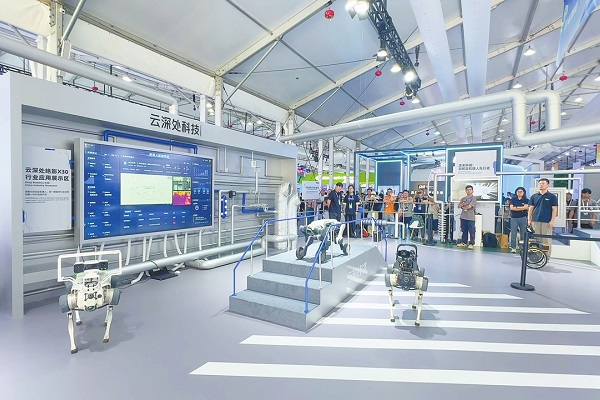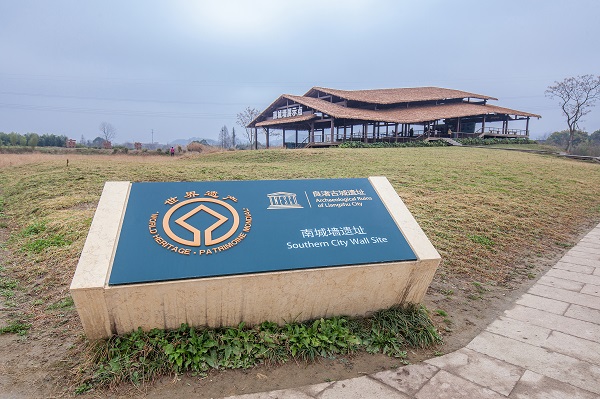Made-in-China robots impress South Koreans as cooperation opportunities expand

Visitors watch a wheeled-leg robot perform stair climbing and slope crossing during the Apsara Conference in Hangzhou, East China's Zhejiang Province on September 26, 2025. Photo: Courtesy of DEEP Robotics
Editor's Note:
The 32nd APEC Economic Leaders' Meeting will be held in South Korea from October 31 to November 1. The Global Times, together with a reporter from South Korea's Maeil Business Newspaper, conducted interviews and surveys on most vibrant areas of bilateral exchange. China's scientific and technological development in emerging industries, such as drones and robotics, is attracting interests from the South Korean community. Meanwhile, the South Korean government and companies are actively investing in humanoid robotics. This installment shares the stories of several Chinese robot companies, talking about the most cutting-edge competition and cooperation areas in the Chinese and South Korean industries.
While robotic dogs are moving from labs and expos to everyday life in China, they are also gaining increasing popularity outside the country. A Morgan Stanley report projects China's robotics market will more than double from $47 billion in 2024 to $108 billion by 2028, with an annual growth of 23 percent. China accounted for about 40 percent of the global robotics market last year, underscoring its rising stature as an innovation hub.
International buyers, especially those from South Korea and Japan, are showing a strong interest in China's rapidly evolving robotics sector, which is driven by significant investments in research and development (R&D), as well as government support for high-tech industries.
In September 2025, South Korea unveiled a 150 trillion won ($108 billion) public-private fund to support investment in artificial intelligence (AI) and other advanced industries. The initiative aims to accelerate AI adoption across sectors and channel resources into key industries, including semiconductors, secondary batteries, biotechnology, energy, hydrogen, defense, vaccine and robotics, over the next five years, according to the Yonhap News Agency.
As South Korea invests heavily in high-tech industries, many Chinese robotics companies, showcasing rapid technological advances in recent years, are capturing the attention of South Korean companies and institutions.
"Many South Korean companies and schools are inquiring about our robots," said Li Changbo, country manager for South Korea and Japan at Hangzhou-based DEEP Robotics, a leading quadruped robot developer, in East China's Zhejiang Province.
In an interview with the Global Times and Maeil Business Newspaper, Li noted that the demand for robotics in South Korea is booming, with numerous visitors from various sectors, including government officials and the press, frequently touring their facilities.
"There is at least one Korean delegation visiting our company every day, and most of them are astonished by the advancements in Chinese technology," he noted. "Many have never been to China or have only seen it through the media. After seeing our products displayed at our South Korean office and understanding our technology, they often exclaim, 'Chinese companies and technology have developed to this level!'"
Founded in 2017, DEEP Robotics focuses on the R&D, production and sales of humanoid and quadruped robots and core components. It primarily targets industrial-grade products, with applications in power inspection, fire safety, factory inspections and education, according to the company's co-founder and CTO Li Chao.
Since 2020, its flagship quadruped dog, X30, tailored for various industry scenarios, has been deployed for autonomous inspections in substations and has been exported overseas in 2024, including its current role in inspecting underground power transmission cable tunnels in Singapore, Li Chao said. The X30 robotic dog has gained international recognition, with SP Group reportedly saving over 480 hours of manual inspection time annually since its deployment.
At this year's China International Fair for Trade in Services in Beijing in September, many South Korean clients showed strong interest in the X30, recognizing it as a standout product, company representative Wei Xuguang told the Global Times at the booth.
Li Changbo noted that South Korea has a strongly pro-robotics stance, especially under the current administration, which emphasizes the importance of AI and robotics in enhancing workplace safety. Following a tragic construction site collapse in Gyeonggi Province in Seoul in April, there has been an increased interest in developing inspection robots for hazardous environments, he added.
After learning that his company has a wide range of application scenarios in factories and construction sites, a Korean company approached and proposed a joint project to build sewer-inspection robots, he said.
"Our products cost about 20-30 percent less than Korean-made robots, but we have more deployment experiences," Li Changbo stated, highlighting the popularity of the X30 quadruped robot series in South Korea. Meanwhile, M20 Lynx, a wheeled-leg hybrid robot built for extreme industrial inspections, has garnered significant interest in both South Korea and Japan.
So far, DEEP Robotics has deployed its solutions in more than 600 scenarios worldwide, with its quadruped robots holding an 80 percent market share in sectors such as power inspection, according to the company.
Growing demand
China is emerging as one of the world's leading forces in robotics, combining AI with smart manufacturing. In recent years, the rapid growth of China's robotics industry has led to the deployment of robots across various sectors, including warehouse logistics, education and entertainment, cleaning services, security inspection and medical rehabilitation, the Xinhua News Agency reported.
As various exhibitions unfold across China this year, the presence of robots, albeit with some hiccups, has captured the attention of both local and international audiences. Analysts said these expos have served as crucial platforms for overseas buyers to explore the latest advancements in robotics and automation technology. The exhibitions showcase a wide range of robotic applications, from industrial automation and logistics to healthcare and service robots.
A humanoid robot from the Shenzhen-based LimX Dynamics entertained spectators with its dance performance at the JD Global Tech Explorer Conference in Beijing in September. According to company representatives, their humanoid robots have already found a market overseas, particularly in South Korea, where universities and businesses are purchasing them for educational research and commercial applications.
Other companies, such as Unitree Robotics in Hangzhou and Inspire Robots in Beijing, confirmed that South Korea is a primary export destination for their robotic products. SenseRobot Go, an AI gaming robot from SenseTime, has also made waves in the international market. Launched in May, it allows users to learn various chess games, retailing at 3,299 yuan. CEO Tang Mingyong noted that a significant portion of their customers in South Korea are elderly customers.
More Chinese robotics startups are entering the South Korean market, leveraging their strengths in producing high-quality, cost-effective products, industry insiders said. In South Korea, primary buyers of robots are often elderly people, reflecting a growing interest in automation and technology among elder demographics.
At the 22nd China-ASEAN Expo, Yao Maoqing, president of Shanghai-based Agibot's embodied intelligence unit, told the Global Times that there is a pressing demand for humanoid robots in Japan and South Korea, with ongoing discussions for future collaborations.
Yao shared his recent experiences in Japan and emphasized that many foreign companies view Chinese robotics firms with admiration, recognizing the challenges of matching China's cost and speed in robot production. This has led to an increased reliance on partnerships with Chinese firms for manufacturing and branding.
The development of robotics industry requires a large number of engineers and other talents, and China has a strong talent dividend in the field, "We are definitely ahead," Yao said.
However, as Chinese robotics firms expand globally, production capacity has been a key constraint, Yao added. This was echoed by his counterpart at DEEP Robotics, who said the company is ramping up production to meet the surging demand from South Korean partners. However, they face challenges related to production capacity, with some partners expressing frustration over delays in order fulfillment.
"Partners everywhere are grumbling about empty shelves," Wang Shixing, DEEP Robotics' sales director for the North and South America, told the Global Times. "One US buyer cornered me after a meeting — order placed three months ago, 100 percent prepaid — and fumed that he was only now taking delivery. I said, 'I get the frustration, but you're cradling the very first Lynx robotic dog we've ever sent to the US.'"
The company's plant in Deqing near Hangzhou runs around the clock, and a second facility built solely for the Lynx line is ramping up, yet output still trails orders. Lead times for DeepRobotics' other quadruped models remain tight at about four weeks, Wang said.
Li Changbo said the burgeoning cooperation between Chinese and South Korean enterprises signifies a promising future for technological collaboration in the region, as both sides seek to leverage their strengths to meet the evolving demands of the robotics industry. "It is expected that by the end of 2025, some robot projects will be mass-produced to meet the needs of the Korean market, and then they can be supplied on a large scale," he added.
-
3rd Liangzhu Forum to be held in Hangzhou from Oct 18-20
October 11, 2025
-
Hangzhou sees tourism boom during National Day, Mid-Autumn holidays
October 9, 2025
-
Hangzhou rolls out cultural, tourism perks
September 29, 2025
-
Visionary Pathway - Hangzhou Playbook
July 15, 2025



